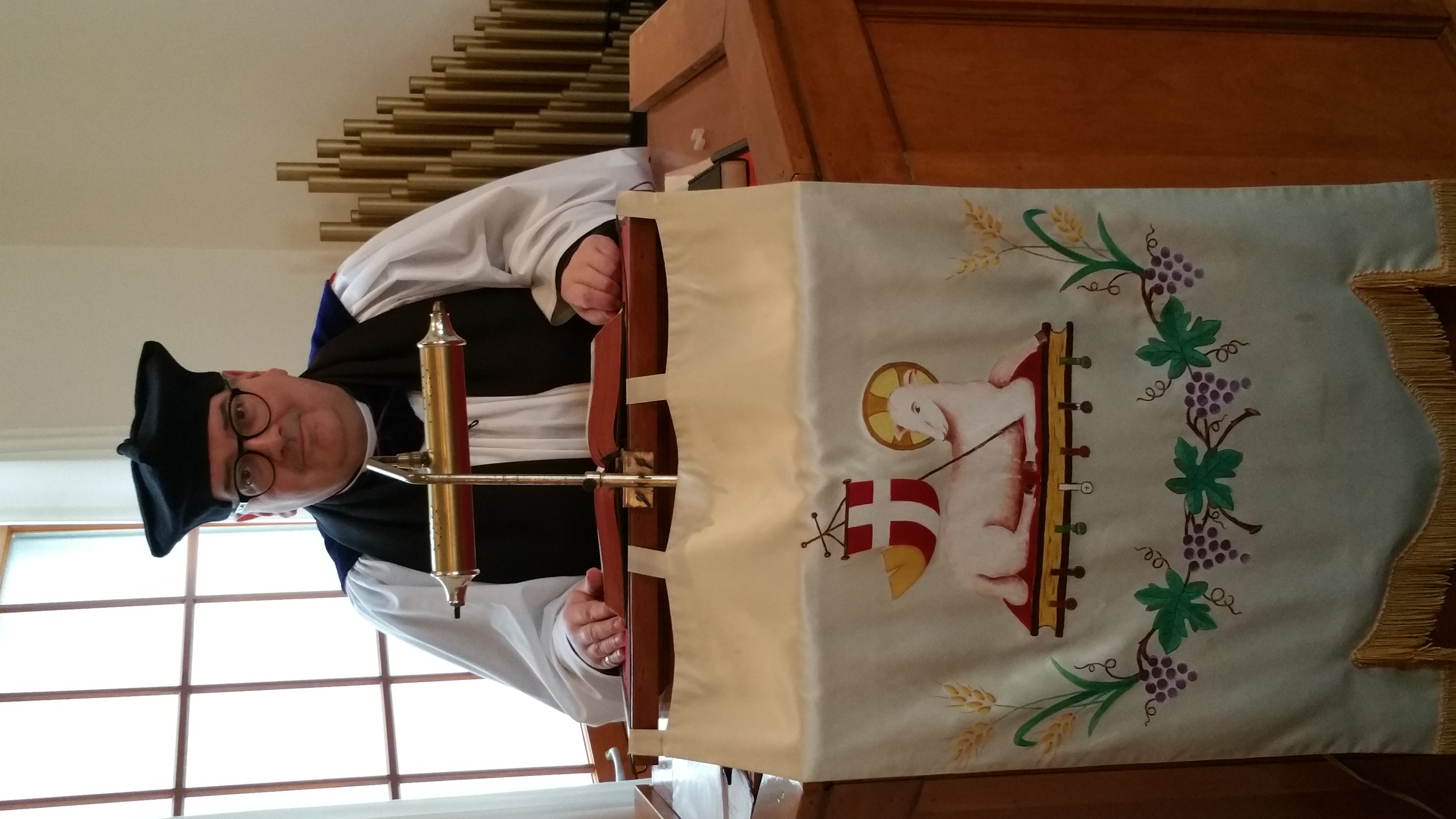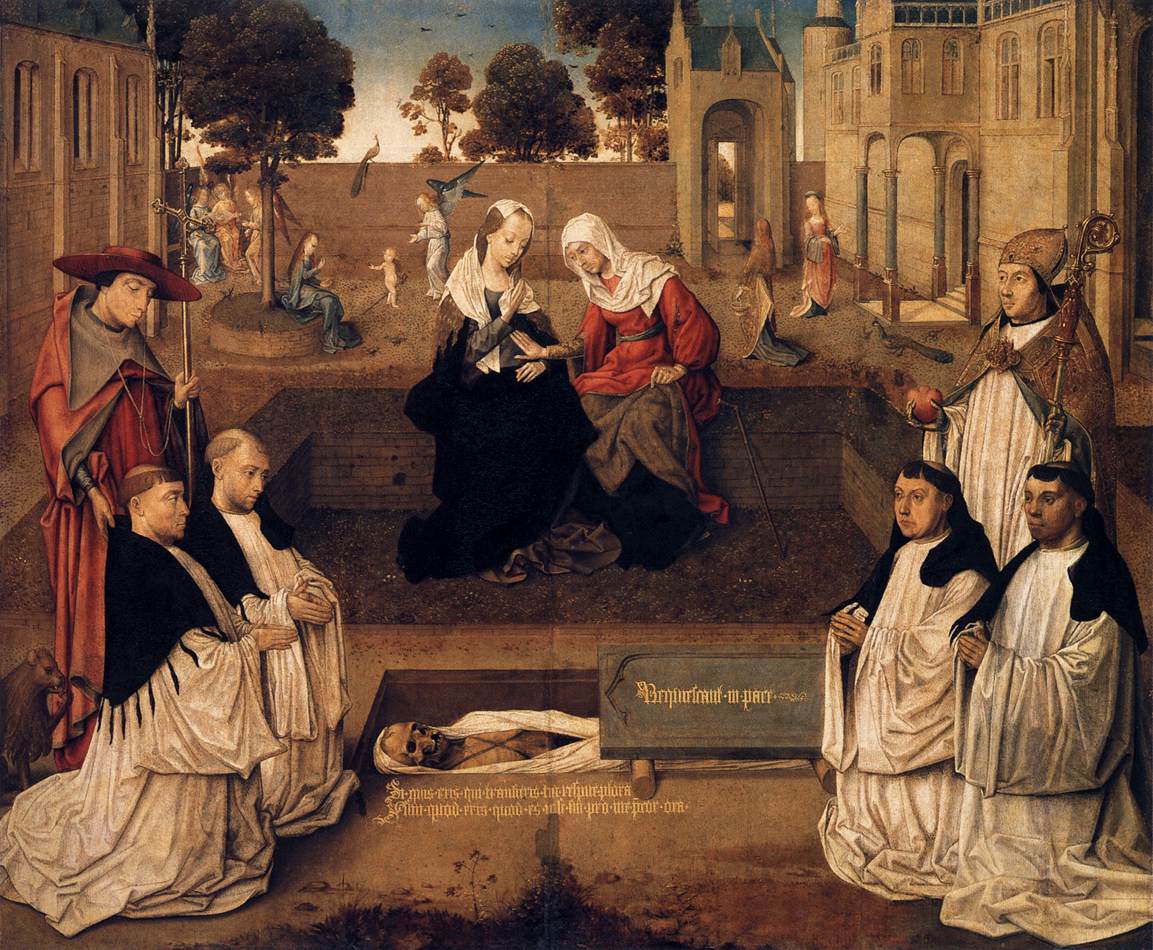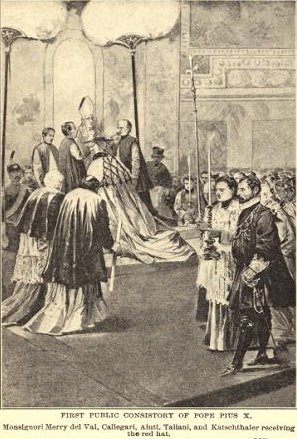|
Biretta
The biretta () is a square cap with three or four peaks or horns, sometimes surmounted by a tuft. Traditionally the three-peaked biretta is worn by Christian clergy, especially Catholic Church hierarchy, Roman Catholic clergy, as well as some Lutheran and Anglican clergy. A four-peaked biretta is worn as academic dress (but not liturgically) by those holding a doctoral degree from a pontifical faculty or pontifical university or faculty. Occasionally the biretta is worn by legal professionals, for instance advocates in the Channel Islands or judges in some Polish courts. Origins The origins of the biretta are uncertain. It is mentioned as early as the tenth century. One possible origin is the academic cap of the high Middle Ages, which was soft and square. This is also the ancestor of the modern mortarboard used today in secular universities. The biretta seems to have become more widely used as an ecclesiastical vestment after the synod of Bergamo, 1311, ordered the clergy ... [...More Info...] [...Related Items...] OR: [Wikipedia] [Google] [Baidu] |
Academic Dress
Academic dress is a traditional form of clothing for academia, academic settings, mainly tertiary education, tertiary (and sometimes secondary schools, secondary) education, worn mainly by those who have obtained a university degree (or similar), or hold a status that entitles them to assume them (e.g., undergraduate students at certain old universities). It is also known as academical dress, academicals, or academic regalia. Contemporarily, it is commonly seen only at graduation ceremonies, but formerly academic dress was, and to a lesser degree in many ancient universities still is, worn daily. Today, the ensembles are distinctive in some way to each institution, and generally consist of a gown (also known as a robe) with a separate hood (headgear), hood, and usually a cap (generally either a square academic cap, a tam (cap), tam, or a Tudor bonnet, bonnet). Academic dress is also worn by members of certain learned societies and institutions as official dress. Overview and h ... [...More Info...] [...Related Items...] OR: [Wikipedia] [Google] [Baidu] |
Canterbury Cap
The Canterbury cap is a square cloth hat with sharp corners. It originated in the Middle Ages, and is commonly found in the Anglican Communion, as well as in the Catholic Church where it is used by Anglican Ordinariate clergy. It is also soft and foldable, "Constructed to fold flat when not in use ..." The Canterbury cap is the medieval ''biretta,'' descended from the ancient '' pileus'' headcovering. It is sometimes called the "catercap". In Anglican churches, clergy are entitled to wear the cap, which is worn for processions and when seated to listen to Scripture or to give a homily, but not when at the Holy Table. It forms part of the "canonical" outdoor clerical dress, along with cassock, gown, and tippet. The cap is made of black velvet for bishops and doctors, otherwise of black wool. In 1899, Percy Dearmer wrote in ''The Parson's Handbook'': A similar cap called the Oxford soft cap is worn today as part of academic dress by some women undergraduates at the Universi ... [...More Info...] [...Related Items...] OR: [Wikipedia] [Google] [Baidu] |
Mortarboard
The square academic cap, graduate cap, cap, mortarboard (because of its similarity in appearance to the mortarboard used by brickmasons to hold mortar) or Oxford cap is an item of academic dress consisting of a horizontal square board fixed upon a skull-cap, with a tassel attached to the centre. In the UK and the US, it is commonly referred to informally in conjunction with an academic gown as a "cap and gown". It is also sometimes termed a square, trencher, or corner-cap. The adjective academical is also used. The cap, together with the gown and sometimes a hood, now form the customary uniform of a university graduate in many parts of the world, following a British model. Origins The mortarboard may have developed from the biretta, a similar-looking hat worn by Roman Catholic clergy. The biretta itself may have been a development of the Roman ''pileus quadratus'', a type of skullcap with superposed square and tump (meaning small mound). A reinvention of this type of ... [...More Info...] [...Related Items...] OR: [Wikipedia] [Google] [Baidu] |
Solemn Mass
Solemn Mass () is the full ceremonial form of a Mass, predominantly associated with the Tridentine Mass where it is celebrated by a priest with a deacon and a subdeacon, requiring most of the parts of the Mass to be sung, and the use of incense. It is also called High Mass or Solemn High Mass. These terms distinguish it from a Low Mass and Missa cantata. The parts assigned to the deacon and subdeacon are often performed by priests in vestments proper to those roles. A Solemn Mass celebrated by a bishop has its own particular ceremonies and is referred to as a Solemn Pontifical Mass. Within the Roman Rite, the history of the Solemn Mass has been traced to the 7th century in the Gregorian Sacramentary and '' Ordo Romanus Primus'', followed by several centuries of adapting these pontifical liturgies. Eventually, the proliferation of multiple parish churches within the same cities saw these liturgies further adapted so that the average priest could celebrate them. By the 13th cen ... [...More Info...] [...Related Items...] OR: [Wikipedia] [Google] [Baidu] |
Cardinal (Catholicism)
A cardinal is a senior member of the clergy of the Catholic Church. As titular members of the clergy of the Diocese of Rome, they serve as advisors to the pope, who is the bishop of Rome and the Head of the Church#Catholic Church, visible head of the worldwide Catholic Church. Cardinals are chosen and formally created by the pope, and typically hold the title for life. Collectively, they constitute the College of Cardinals. The most solemn responsibility of the cardinals is to elect a new pope in a Papal conclave, conclave, almost always from among themselves, with a few historical exceptions, when the Holy See is Sede vacante#Vacancy of the Holy See, vacant. During the period between a pope's death or resignation and the election of his successor, the day-to-day governance of the Holy See is in the hands of the College of Cardinals. The right to participate in a conclave is limited to cardinals who have not reached the age of 80 years by the day the vacancy occurs. With the pope ... [...More Info...] [...Related Items...] OR: [Wikipedia] [Google] [Baidu] |
Canons Regular
The Canons Regular of St. Augustine are Catholic priests who live in community under a rule ( and κανών, ''kanon'', in Greek) and are generally organised into Religious order (Catholic), religious orders, differing from both Secular clergy, secular canons and other forms of religious life, such as clerics regular, designated by a partly similar terminology. As religious communities, they have laybrothers as part of the community. At times, their Orders have been very popular: in England in the 12th century, there were more houses of canons (often referred to as an abbey or canonry) than monasteries of monks. Preliminary distinctions All canons regular are to be distinguished from canon (priest), secular canons who belong to a resident group of priests but who do not take religious vows, public vows and are not governed in whatever elements of life they lead in common by a historical rule. One obvious place where such groups of priests are required is at a cathedral, where ... [...More Info...] [...Related Items...] OR: [Wikipedia] [Google] [Baidu] |
Papal Consistory
In the Catholic Church, a consistory is a formal meeting of the College of Cardinals called by the pope. There are two kinds of consistories, extraordinary and ordinary. An "extraordinary" consistory is held to allow the pope to consult with the entire membership of the College of Cardinals. An "ordinary" consistory is ceremonial in nature and is normally attended by cardinals resident in Rome. For example, the pope elevates new cardinals to the College at a consistory; Pope Francis called consistories for ceremonies of canonization; and Pope Benedict announced his decision to retire in 2013 at a consistory. A meeting of the College of Cardinals to elect a new pope is not a consistory, but a conclave. History The term ''consistory'' comes from the ; "stand together".''Papal Consistory'' by Kevin Knight (Catholic Encyclopedia, 2009) ... [...More Info...] [...Related Items...] OR: [Wikipedia] [Google] [Baidu] |
Galero
A (plural: ; from , originally connoting a helmet made of skins; cf. '' galea'') is a broad-brimmed hat with tasselated strings which was worn by clergy in the Catholic Church. Over the centuries, the red ''galero'' was restricted to use by individual cardinals while such other colors as black, green and violet were reserved to clergy of other ranks and styles. Description When creating a cardinal, the pope used to place a scarlet ''galero'' on the new cardinal's head during the papal consistories, the practice giving rise to the phrase "receiving the red hat." In 1969, Pope Paul VI issued a decree ending the use of the ''galero''. Since that time, only the scarlet '' zucchetto'' and '' biretta'' are placed over the heads of cardinals during the papal consistory. Some cardinals continue to obtain a ''galero'' privately so that the custom of suspending it over their tombs may be observed. Raymond Cardinal Burke has been known to publicly wear the ''galero'' on occasion ... [...More Info...] [...Related Items...] OR: [Wikipedia] [Google] [Baidu] |
Low Mass
Low Mass (Latin ''Missa Privata'') is a Mass celebrated by a priest without the assistance of sacred ministers (deacon and subdeacon). Before the 1969 reforms, a sub-distinction was also made between the '' sung Mass'' (), when the celebrant still chants those parts which the rubrics require to be chanted, and the ''low Mass'' () where the liturgy is spoken. In a low Mass, the priest may be assisted by altar boys ( acolytes) rather than deacons, and use appropriately simplified rubrics. A full sung Mass celebrated with the assistance of sacred ministers is a High or Solemn Mass. The celebration of Low Mass occurred in the Roman Rite, prior to the 1969 reforms in the Catholicism, and continues in Lutheranism, as well as parts of Anglicanism. History Low Mass originated in the early Middle Ages as a shortened or simplified form of Solemn Mass. In the early church, as in the Eastern Orthodox church today, all services were chanted, and there was no equivalent to the Roman Low ... [...More Info...] [...Related Items...] OR: [Wikipedia] [Google] [Baidu] |
Bishop (Catholic Church)
In the Catholic Church, a bishop is an Holy orders in the Catholic Church, ordained Minister (Catholic Church), minister who holds the fullness of the Sacraments of the Catholic Church, sacrament of holy orders and is responsible for teaching doctrine, governing Catholics in his Ecclesiastical jurisdiction, jurisdiction, sanctifying the world and representing the church. Catholics trace the origins of the office of bishop to the Apostles in the New Testament, apostles, who it is believed were endowed with a special charism and office by the Holy Spirit in Christianity, Holy Spirit at Pentecost. Catholics believe this special charism and office has been transmitted through an apostolic succession, unbroken succession of bishops by the laying on of hands in the sacrament of holy orders. Diocesan bishops—known as eparchial bishops in the Eastern Catholic Churches—are assigned to govern local regions within the Catholic Church known as dioceses in the Latin Church and Eparchy ... [...More Info...] [...Related Items...] OR: [Wikipedia] [Google] [Baidu] |
Deacon
A deacon is a member of the diaconate, an office in Christian churches that is generally associated with service of some kind, but which varies among theological and denominational traditions. Major Christian denominations, such as the Catholic Church, the Oriental Orthodox Churches, the Eastern Orthodox Church, Lutheranism, Presbyterianism, Methodism, and Anglicanism, view the diaconate as an order of ministry. Permanent deacons (or distinctive deacons) are those who do not later transition to another form of ministry, in contrast to those continuing their formation who are then often called transitional deacons. Origin and development The word ''deacon'' is derived from the Greek word (), which is a standard ancient Greek word meaning "servant", "waiter", "minister", or "messenger". Recent research has highlighted the role of the deacon "as a co-operator" and "go-between," emphasizing their intermediary position in early Christian communities. It is generally assum ... [...More Info...] [...Related Items...] OR: [Wikipedia] [Google] [Baidu] |
Zucchetto
The zucchetto (, also ,"zucchetto" (US) and , ; meaning 'small gourd', from ''zucca'' 'pumpkin' or more generally 'gourd'; plural in English: zucchettos) or solideo, officially a pileolus, is a small, hemispherical, form-fitting ecclesiastical cap, skullcap worn by clergy, clerics of various Catholic Church, Catholic Churches, the Syriac Orthodox Church, by senior clergy in certain denominations of Lutheranism, as well as Anglicanism, and in certain cases by senior clergy in Methodism. It is also called a pilus, pilos, pileus, pileolo, subbiretum, submitrale, soli deo, berrettino, calotte or calotta. History The zucchetto originated as the Paleo-Balkanic ''Pileus (hat ...[...More Info...] [...Related Items...] OR: [Wikipedia] [Google] [Baidu] |







